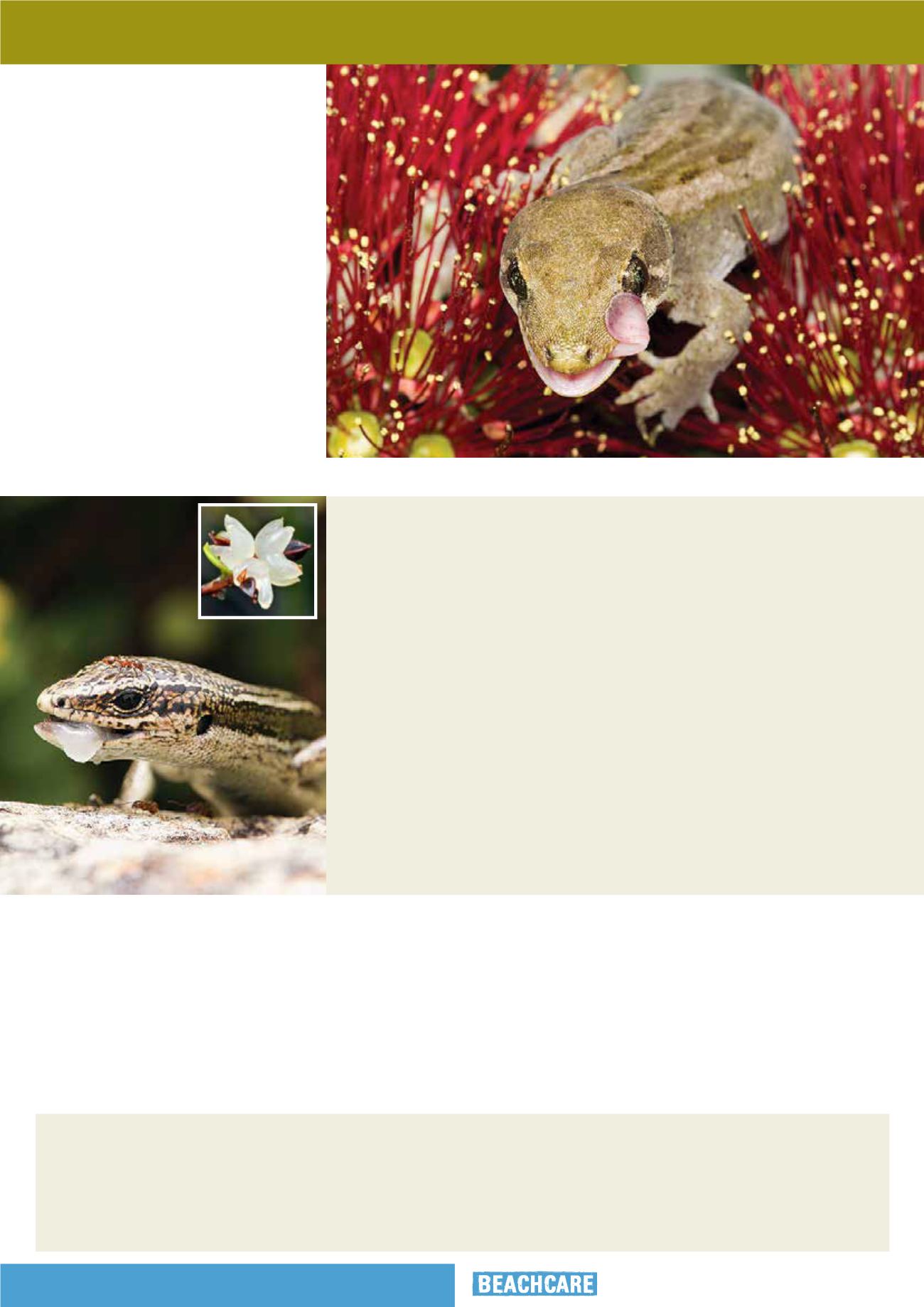
23
Magazine
New Zealand’s native lizards play an important
role in pollinating coastal plant species and
spreading their seeds. Geckos regularly visit
flowers to feed on nectar from coastal species
such as pōhutukawa and harakeke, and in
the process collect and transfer considerable
amounts of pollen.
New Zealand’s native geckos and skinks include
large quantities of fleshy fruit in their diet
during summer from common coastal plants
such as sand coprosma, taupata, kawakawa
and pōhuehue. Because of the size, colour, and
positioning of the fruit, it appears that some
divaricating shrubs or vines may be specifically
adapted to seed dispersal by lizards
(Whitaker, 1987).
Attract lizards to your backyard
Lizards can thrive in suburban gardens and rural properties if you meet their needs for food
and shelter. Look around your backyard and find a warm, dry, sunny place. The most important
thing for lizards is cover, and you can use rock or wood piles. Loosely stack old concrete, bricks
and stones so there are plenty of cracks and holes. Spiders, slaters and beetles will head inside,
especially when it’s cold, and that’s good news for the lizards that feed on them! A good pile of
dead wood is an adventure playground for lizards. Pile up a few logs and bits of wood and leave
them to slowly rot, undisturbed.
When it comes to selecting plants for lizard habitat the rule is to plant thickly. Lizards need safe
habitats to run to when cats are on the prowl. That means thick ground cover, vines and dense plant
growth on banks. Berry or nectar-producing plant species are good, especially native divaricating
shrubs, and if you have a range of plants the lizards will have plenty to eat all year round.
Coprosma species, pōhuehue and kawakawa, provide fruit, while mānuka and rātā give nectar.
Ferns, tussock grasses and rengarenga provide thick ground cover and attract insects for the
lizards to eat.
Left: A moko skink eating pōhuehue fruit. Photo: Neil Fitzgerald.
Inset: Pōhuehue fruit. Photo: Bryce McQuillan.
Onduline is an extremely tough, lightweight
corrugated roofing and cladding product made
from organic fibres saturated with bitumen.
Sheets are 2 metres long and can be cut into
smaller pieces (290 mm x 400 mm or larger)
with a handsaw or skillsaw. These should be
stacked two or three high with small stones in
between the layers. Place your lizard home in a
warm, dry, sunny area with good cover, such as
divaricating shrubs, tussocks and rock piles.
More tips:
• Mulch your garden heavily – it will improve
water retention for plants and also create
a humid environment for lizards and their
invertebrate prey.
• Design stone walls, retaining walls or
embankments that have plenty of small gaps,
cracks and crevices, and encourage fungi,
plants and vines to grow on them.
• Be patient. If your lizards have already gone,
it may be a little while before they return.
Onduline lizard home
References
Bergin et al. Restoration of a degraded pōhutukawa forest remnant, Kawhia.
Establishment of a pilot planting trial. Report to Waikato Regional Council. 2010.
Forest Research Institute 1989
Bergin, D. Hosking, G. Pōhutukawa Ecology, Establishment, Growth and Management.
NZFRI. 2006.
Schnackenberg, Edward Henry.
The Pōhutukawas of Kawhia: tales, traditions and
legends relating to Kawhia’s famous Christmas trees
. Kawhia Settler. 1935.
A. H. Whitaker (1987) The roles of lizards in New Zealand plant reproductive
strategies, New Zealand Journal of Botany, 25:2, 315-328
Encourage our pollinators
Geckos can be important pollinators of some New Zealand plants. Here a Mokohinau gecko licks excess pollen from its face as it crawls
over the flowers of a pōhutukawa tree on the Mokohinau Islands in the Hauraki Gulf. Photo: Neil Fitzgerald.


